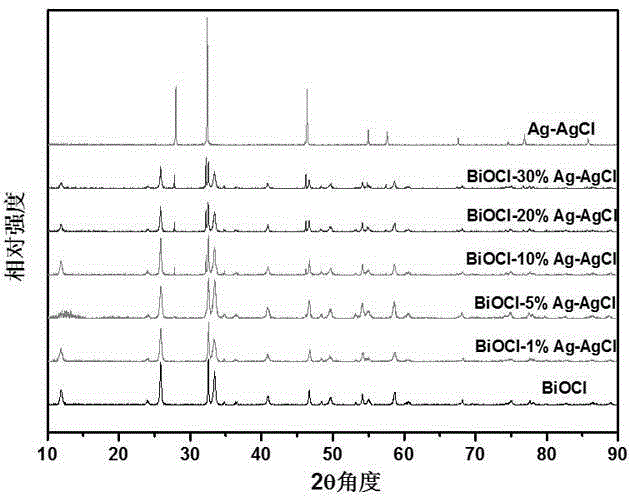Visible-light-driven photocatalyst Ag-AgCl-BiOCl and preparation method and application thereof
A catalyst and visible light technology, applied in chemical instruments and methods, light water/sewage treatment, textile industry wastewater treatment, etc., to achieve the effect of improving utilization rate and catalytic activity
- Summary
- Abstract
- Description
- Claims
- Application Information
AI Technical Summary
Problems solved by technology
Method used
Image
Examples
Embodiment Construction
[0024] 1. Preparation of Ag-AgCl-BiOCl composite photocatalyst by mixed solvent coprecipitation method
[0025] BiOCl preparation: 12mmolBi(NO 3 ) 3 ?5H 2 O solid was added to 24-25 ml of ethylene glycol (EG, ethyleneglycol) solution, and then heated at 70-80° C. and magnetically stirred for 20-30 minutes to form a transparent solution A. Dissolve a certain quality of KCl in 96-100 ml of water (H 2 O), so that the number of moles of KCl is equal to that of Bi(NO 3 ) 3 ?5H 2 moles of O to obtain solution B. The volume ratio of ethylene glycol and water in solutions A and B keeps EG:H 2 O=1 / 4. Add solution B to solution A dropwise, then adjust the pH of the mixture to 6-7 with ammonia water, and magnetically stir at 60-70° C. for 60-70 minutes. The precipitate was separated by centrifugation, washed 2-3 times with deionized water and ethanol respectively, and dried at 60-65° C. to obtain a BiOCl solid.
[0026] preparation: With the preparation method of above-me...
PUM
 Login to View More
Login to View More Abstract
Description
Claims
Application Information
 Login to View More
Login to View More - R&D
- Intellectual Property
- Life Sciences
- Materials
- Tech Scout
- Unparalleled Data Quality
- Higher Quality Content
- 60% Fewer Hallucinations
Browse by: Latest US Patents, China's latest patents, Technical Efficacy Thesaurus, Application Domain, Technology Topic, Popular Technical Reports.
© 2025 PatSnap. All rights reserved.Legal|Privacy policy|Modern Slavery Act Transparency Statement|Sitemap|About US| Contact US: help@patsnap.com



